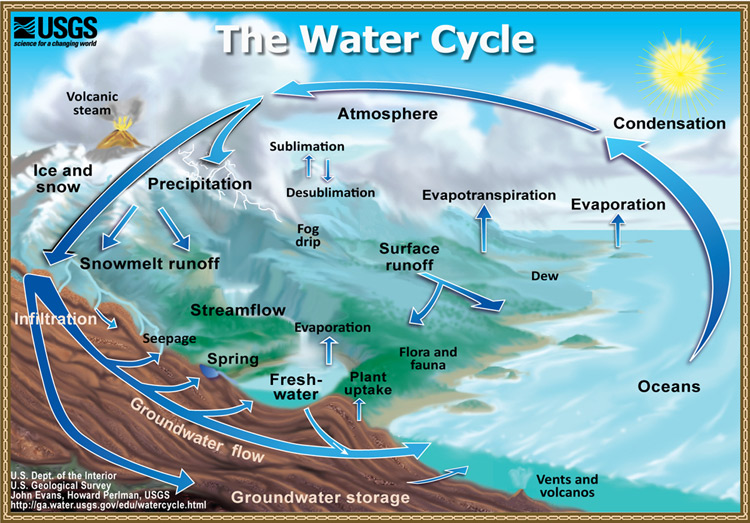What Is the Second Step of the Water Cycle
Sublimation is when precipitation returns to the earth as snow or ice. This cycle consists of three major steps along with a few additional steps.

The Water Cycle A Guide For Student Apec Water
What is the second part of the water cycle.

. The water cycle is the journey water takes as it moves from the land to the sky and back again. The water in the cup which represents the ocean evaporates liquid to a gas and then condenses gas to a liquid when it hits the cup of ice which represents the cooler air masses in the upper atmosphere. The next stage of the water cycle is sublimation.
Condensation is the transformation of water vapor into liquid. The significant processes in the water cycle are evaporation transpiration condensation precipitation and runoff. The cycle starts all over again.
Precipitation This is where the clouds became heavy. What does soil have to do with the water cycle. Were committed to ensuring our programs are culturally relevant affirming and.
Up to 24 cash back This is the main way in which water cycle returns its to the earth. The water cycle shows how water is exchanged through the Earths land ocean and atmosphere. When there is more water than the land can absorb runoff occurs.
What is the second step in the water cycle. When theyre heavy they cannot hold the water for too long. Condensation is the transformation of water vapor into liquid.
The Nonprofit Behind the Second Step Family of Programs. Discover hundreds of never-before-seen resources. The reaction is catalysed by citrate synthase.
Sublimation occurs when the snowice does not melt skipping the liquid phase and instead coverts back to a gas. It is an eight-step process. It is the amount of water that reaches the streams and rivers.
The water falling on land collects in rivers and lakes soil and porous layers of rock and much of it flows back into the oceans where it will once more evaporate. The first step is the condensation of acetyl CoA with 4-carbon compound oxaloacetate to form 6C citrate coenzyme A is released. This is the stage of the water cycle that creates clouds which are necessary for rain and snow formation.
In which step of the water cycle does the water return to land and falls from the clouds. Because of this cycle water always exists in all three of those places as well in many forms. From our headquarters in Seattle Washington we partner with researchers policymakers and thought leaders around the world to fulfill our vision of safe children thriving in a peaceful world.
This water goes into oceans lakes and streams. So are all you budding young geographers ready to learn some splashing new facts. The second stage of the water cycle is condensation.
The water cycle describes how water evaporates from the surface of the earth rises into the atmosphere cools and condenses into rain or snow in clouds and falls again to the surface as precipitation. The water cycle. Water Cycle Step 2.
Hypotheses _____ are just as likely to be proven true or false. Snow falling on a glacier during winter months usually replaces any water that melts away in the summer. In which step of the water cycle is the water is turned into liquid.
In a negative feedback loop if one variable _____ the second variable increases. There it supplies water for plants and the groundwater that we drink. This is actually a two-step process involving first the removal and then the addition of a water molecule which is why the citric acid cycle is sometimes described as having.
Runoff refers to the water discharged after infiltration and percolation. Condensation is when water vapor is collected and mixed together with dust thus forming a cloud. In a positive feedback loop if one variable increases the second variable _____In a negative feedback loop if.
Condensation is the process of water turning from a gas into a liquid. The worlds water moves between lakes rivers oceans the atmosphere and the land in an ongoing cycle called you guessed it. All living systems in the _____ depend on earths other systems to survive.
After some time the condensed water vapor falls to the rock which represents the Earth and eventually makes its way back to the ocean Once the water cycle has begun to. Water condenses to form clouds. The three major water cycle steps are evaporation condensation and precipitation.
Water from melting snow and ice also goes into the soil. Evaporation a process where water disappears because of heat and becomes water vapor. Krebs cycle or TCA cycle takes place in the matrix of mitochondria under aerobic condition.
Water vapor rises up in the sky due to the suns heat. As it goes through this continuous system it can be a liquid water a gas vapour or a solid ice. Once the water vapor rises high enough it condenses into water droplets.
In the second step citrate is converted into its isomer isocitrate. You have probably experienced condensation if you have had a cold glass of water at a restaurant. It follows a cycle of evaporation condensation precipitation and.
Create your free account at httpsmyhappylearningtv and start learning in the most entertaining wayWh. The Suns heat causes glaciers and snow to melt into liquid water.


Comments
Post a Comment